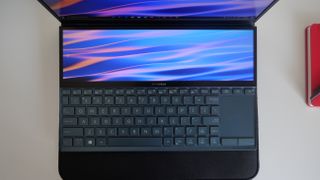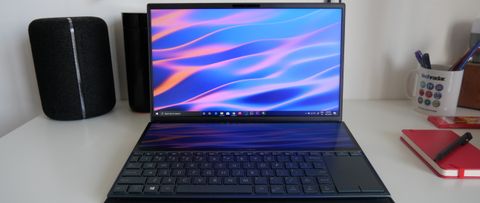Why you can trust TechRadar
Performance
3DMark Sky Diver: 9,478; Fire Strike: 2,784; Time Spy: 1,019
Cinebench R20 CPU: 453 (single core); 1,712 (multi-core)
CrystalDiskMark 6: 3553.3 MB/s (Seq read); 2390.6 MB/s (Seq write)
PCMark 8 Battery Life: 6 hours and 12 minutes
Battery Life (TechRadar movie test): 5 hours and 11 minutes
The ZenBook Duo is aimed at professionals and creators, so its a given that it packs pretty decent hardware. It comes with the choice of either a 10th generation Intel Core i7 processor or Core i5 with up to 16GB RAM and 1TB NVMe PCIe SSD and 2GB NVIDIA GeForce MX250 graphics.
This configuration clearly means that the ZenBook Duo is a beefy machine that can handle most tasks. Especially, making multitasking on it a joy, which is just as well considering the second screen, which encourages you to run multiple apps at once.
During our time with the Asus ZenBook Duo, we were very impressed with how the laptop performed. Windows 10 felt lively, apps opened quickly, and there’s no pause when you drag open apps and windows between screens.
We ran a multitude of software that creators use, including Adobe Premiere Pro, Photoshop, Illustrator and CorelDraw, to name a few, and not for once did the ZenBook Duo show any signs of stress. The second screen comes in handy during video editing processes as a user can drag different windows to the second screen, such as the timeline, and control it via touch input. However, it will take some time for users to get around their default workflow.
The laptop features Asus’ Sonic Master stereo system backed by smart amplifiers and is certified by Harman Kardon. Its microphones support Cortana and Amazon Alexa's voice-recognition and improved low-frequency response.
We did struggle to run some games – hence why there’s no Shadow of the Tomb Raider benchmark. So, while the Asus ZenBook Duo could, in theory, be a decent gaming laptop, we’d advise against buying it for the sole purpose of playing games on.
As a workstation, though, the Asus ZenBook Duo is an excellent performer with some substantial – and future-proof – components driving the whole thing.
Keyboard & I/O

ZenBook Duo has a full-size backlit keyboard situated at the bottom half of the base with a touchpad that supports up to four-finger gestures. The keyboard is well-designed with an exact amount of key travel that enables a breezy workflow.
However, as it is positioned below the second screen with little space to rest your wrists, it felt uncomfortable to us, and many might find the same issue. Sadly, there isn’t a workaround for this, but it would have been great if Asus provided a wrist-rest with this laptop as it does with the ZenBook Pro Duo.
The trackpad is weirdly placed and occupy’s a smaller area than regular touchpads. More than the keyboard, users could have a hard time adjusting to the small trackpad, especially if you don’t use an external mouse. And unlike the Pro Duo, the touchpad on this laptop isn’t integrated with an LED numeric keypad, which means that even if you connect it with an external mouse, the trackpad area is still left unused.
The compromises in ergonomics wouldn’t be so much of a deal-breaker if Asus had provided a wrist-rest and integrated its NumberPad on the touchpad as well.As for the I/O ports, the ZenBook Duo comes with a single USB 3.1 Gen 2 Type-C, USB 3.1 Type-A, USB 3.1 Gen 1 Type-A, an HDMI port, and a microSD card reader. So, you’re covered with these essential interfaces, which shouldn’t give you a hard time as Apple gives to its MacBook users with a “dongle-life.”
The laptop also has Wi-Fi 6 built-in, which is around 30% faster than Wi-Fi 5, offering speeds up to 10Gbps.


As for the I/O ports, the ZenBook Duo comes with a single USB 3.1 Gen 2 Type-C, USB 3.1 Type-A, USB 3.1 Gen 1 Type-A, an HDMI port, and a microSD card reader. So, you’re covered with these essential interfaces, which shouldn’t give you a hard time as Apple gives to its MacBook users with a “dongle-life.”
The laptop also has Wi-Fi 6 built-in, which is around 30% faster than Wi-Fi 5, offering speeds up to 10Gbps.
Battery Life
The ZenBook Duo is fitted with a 70Wh 4-cell Li-Po battery that Asus claims can last for up to 22 hours. And while that’s a tall claim to make going by the laptop standards, we tested the laptop looping a 1080p video on the screen, and it died down on us in five hours and 11 minutes.
With both the screens set to maximum brightness, the PCMark 8 Home battery benchmark was only slightly better than our video loop test, clocking in at 6 hours and 12 minutes. If one disables the ScreenPad Plus, the laptop will last for a bit more time on a single charge, but it’s probably something you’d not want to do.
However, while editing or performing intensive tasks, you’ll pretty much need is always to be plugged into a power socket for best performance. Overall, the ZenBook Duo has a decent battery life, but don’t set your expectations high.
Verdict
Asus has tried to do something different with the ZenBook Duo, and while it’s not an unmitigated success, we have to give the company props for giving it a go.
While the build quality and hardware of the ZenBook Duo is undoubtedly worthy of praise, its most significant selling point – the Screenpad Plus doesn’t quite justify the additional weight that it adds to the laptop.
There are a few excellent features that come with the second screen, and with a bit of tweaking, many people may be able to set it up to work in a way that is genuinely helpful for improving productivity. For example, having an app open on the bottom screen can be useful, and frees up space on the main screen.
But is it that useful? We’d argue not. The ScreenPad Plus doesn’t offer a seamless experience between two separate displays and compromises with ergonomics. You’ll need to ask yourself if you’re willing to make those compromises for the Screenpad Plus. And we know many people won’t.
However, we hope this isn’t the last we see of the ScreenPad Plus. Future laptops could better integrate a second screen while keeping the size and weight of the laptop down. Apple had persisted with the Touch Bar – which was pretty much unloved when it first appeared – and we expect Asus to do the same with the ScreenPad Plus.
Meanwhile, we continue to wait for a genuinely disruptive new form factor for laptops. Perhaps the future lies with laptops with foldable screens. For now, though, the Asus ZenBook Duo remains more of a curio than a breakthrough, but there will be a select few people who will fall in love with this unique laptop.

